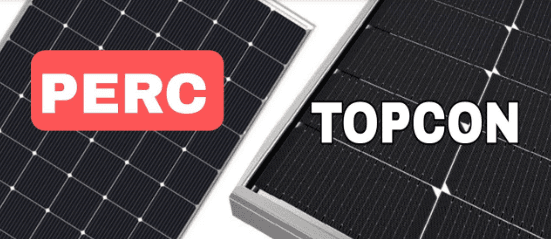Abhishek Bana
Green Entrepreneur
A Showdown: Topcon vs. PERC Solar Cells

In the quest for more efficient and cost-effective solar energy solutions, the solar industry has seen remarkable advancements in photovoltaic (PV) technology. Two prominent contenders in this arena are Topcon (Tunnel Oxide Passivated Contact) and PERC (Passivated Emitter and Rear Cell) solar cells. Both have their unique characteristics, advantages, and applications, sparking debates among solar enthusiasts and industry experts alike. Before diving into the comparison, let’s grasp the fundamentals of each technology:
Topcon Solar Cells:
Topcon cells feature a thin layer of tunnel oxide on the surface, which acts as a passivation layer. This layer helps in reducing electron-hole recombination losses, thereby enhancing the cell’s efficiency. The rear surface of the cell typically utilizes a high-quality passivated contact to improve performance further.
PERC Solar Cells:
PERC technology revolutionized the solar industry by introducing a passivation layer on the rear side of the cell, thereby mitigating surface recombination. This innovation significantly increased light absorption and electron capture, leading to higher efficiency and power output. PERC cells have gained widespread adoption due to their compatibility with existing production lines and relatively low manufacturing costs.
Comparing Efficiency and Performance
When it comes to efficiency, both Topcon and PERC cells excel, but they achieve it through different mechanisms. PERC cells are renowned for their ability to achieve high efficiency levels, often exceeding 20%. On the other hand, Topcon cells boast impressive efficiency by minimizing losses at the front and rear surfaces, often rivaling or even surpassing PERC cells in certain conditions.
Cost and Manufacturing Considerations
Cost-effectiveness plays a crucial role in determining the viability of solar technology. PERC cells have gained popularity due to their compatibility with standard production processes, enabling manufacturers to upgrade existing lines without significant investment. However, Topcon cells, while offering impressive performance, may require specialized production techniques, potentially increasing manufacturing costs.
Application and Market Dynamics
The choice between Topcon and PERC cells often depends on specific application requirements and market dynamics. PERC technology dominates the mainstream solar market due to its proven track record, reliability, and cost-effectiveness. It is widely used in utility-scale projects, commercial installations, and residential rooftops. On the other hand, Topcon cells find niche applications where maximizing efficiency is paramount, such as space-constrained installations or premium solar products targeting high-end markets.
Future Prospects and Innovations
As the solar industry continues to evolve, both Topcon and PERC technologies are subject to ongoing research and development efforts aimed at further improving efficiency, reducing costs, and expanding applicability. Emerging innovations such as TOPCon-IBC (Interdigitated Back Contact) and HJT (Heterojunction) solar cells are pushing the boundaries of efficiency and performance, promising exciting prospects for the future of solar energy.
Conclusion
In the Topcon vs. PERC showdown, there’s no clear winner; rather, each technology offers a unique set of advantages and applications. PERC cells dominate the mainstream market with their proven efficiency and cost-effectiveness, while Topcon cells cater to specialized niches where maximizing performance is paramount. As the solar industry marches towards a sustainable future, both technologies will continue to play pivotal roles in harnessing the power of the sun to meet our energy needs.
References
- Al-Amin, M., Islam, M. M., Hasanuzzaman, M., & Rahim, N. A. (2021). A comprehensive review on high-efficiency passivated emitter and rear contact (PERC) silicon solar cells. Solar Energy, 220, 369–394. doi:10.1016/j.solener.2021.01.052
- Green, M. A., Dunlop, E. D., Levi, D. H., Hohl-Ebinger, J., Yoshita, M., & Ho-Baillie, A. W. (2019). Solar cell efficiency tables (version 54). Progress in Photovoltaics: Research and Applications, 27(1), 3–12. doi:10.1002/pip.3141
- Lin, H., Zhang, H., Yao, X., Wang, W., Wu, H., Zhao, H., & Shen, H. (2016). Top-con cells on n-type silicon wafers. Solar Energy Materials and Solar Cells, 145, 186–191. doi:10.1016/j.solmat.2015.10.007
- Müller, J., Hermle, M., & Glunz, S. W. (2015). PERC solar cell technology: from R&D to mass production. IEEE Journal of Photovoltaics, 5(5), 1319–1326. doi:10.1109/JPHOTOV.2015.2447315
- Yang, G., Wu, J., Meng, F., Gao, P., Xiao, S., Yu, Z., & Yang, B. (2017). Review of silicon photonics foundry efforts. Micromachines, 8(6), 182. doi:10.3390/mi8060182
